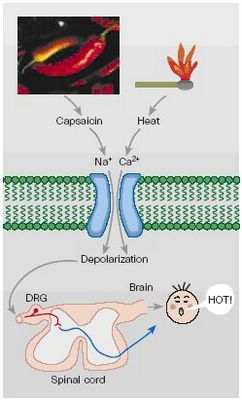This one goes out for all my friends that love spicy food. It’s taken from an article of Nature magazine (vol 389, 23/10/1997). May you now know more about your CRAZY habits!!!
This sequence of petty disasters is repeated daily by hot-food novices eating at Malaysian, Mexican, Indian, Chinese, Indonesian and other restaurants serving cuisine from the tropical belt. Two questions come to mind.
First, how do hot spices do this to our nervous system? Second, why do we do this to ourselves (after all, the menu said it was hot)?
To answer the first question, members of David Julius’ laboratory have identified the protein that comprises the receptor for capsaicin, the molecule that makes chilli peppers seem hot. Capsaicin is found in the white ‘ribs’ inside hot chilli peppers, and it elicits the familiar sense of burning pain.
It is just one molecule in the chemical-warfare armoury of plants and, presumably, it was designed to protect plants from being eaten (humans, of course, ignore this polite warning).
Capsaicin is so potent that its effects are calibrated by the spice industry in a sort of taste Richter scale (Scoville heat units), ranging from Bell peppers (<1),>
In 1912, Wilbur Scoville calibrated the potency of pepper by extracting capsicum in alcohol and diluting it until pungency was just detected after placing a drop on his tongue. Although Dr Scoville is no longer around to assign heat units, the scale is still a subjective psychophysical one.
This is how it more or less works:

Hot peppers and painful heat both activate sensory nerve fibres through an ion channel. The channel, known as vanilloid receptor subtype 1 (VR1), is activated by binding of capsaicin — the compound that makes chilli peppers hot. When activated, the channel opens, allowing an influx of calcium and sodium ions. The influx depolarizes neuronal pain fibres, initiating a nerve impulse through the dorsal root ganglion (DRG) to the brain. Noxious temperature uses the same elements, explaining why our mouths feel hot when we eat chilli peppers.
Interestingly, capsaicin is lipophilic and might bind the channel from either the exterior or interior of the cell. Its affinity for fat also explains why drinking more water after a spicy mouthful spreads the fire around, whereas absorbing the spice with food is more effective."

1 Comments:
Great article man!
I now understand why I love spicy food so much!!!
Post a Comment
<< Home